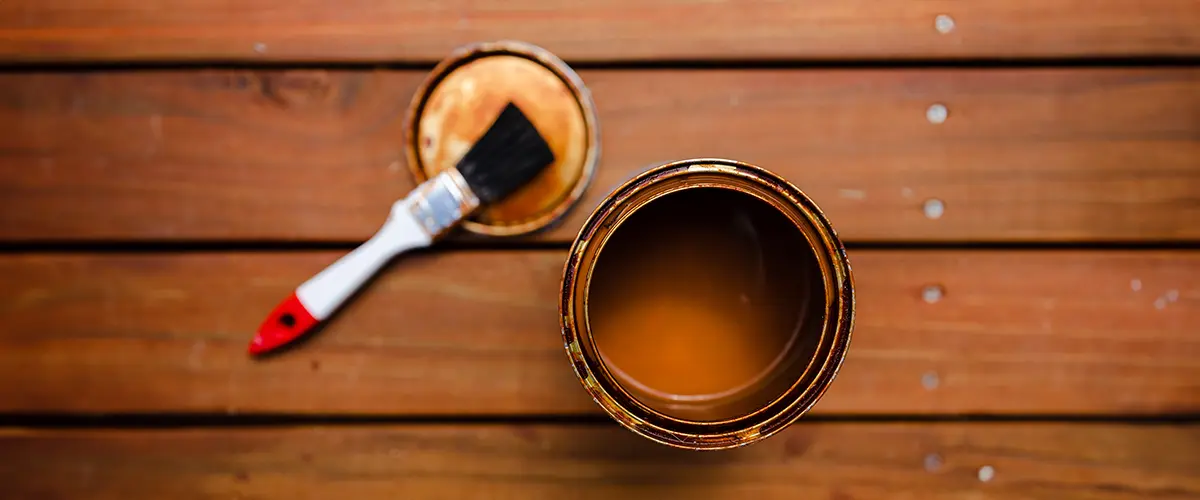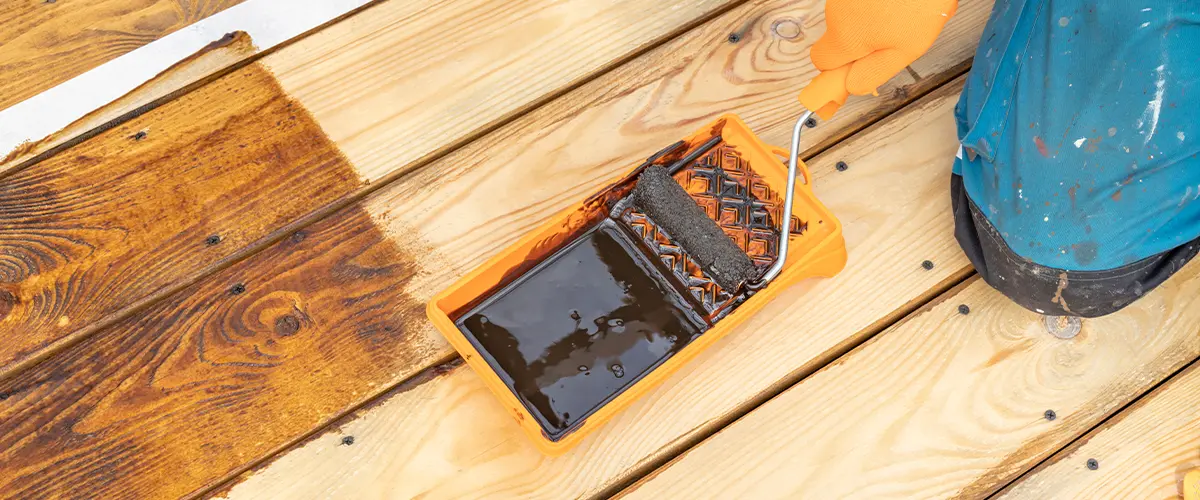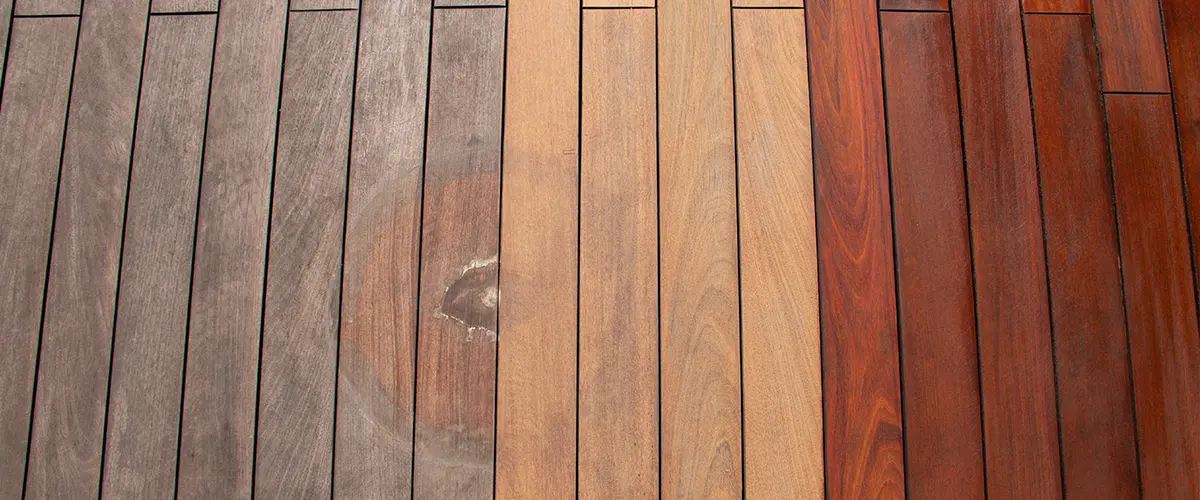Oil Based Deck Stain Vs Water Based: Choosing The Best For Your Deck
Selecting the right deck stain can be a challenging decision. Many homeowners don’t realize that the type of stain you choose significantly affects both the appearance of your deck and the maintenance it requires. In this article, we’ll explore the differences between oil-based and water-based deck stains, helping you determine which option is best for your deck.
Keep reading to find out more!

Key Differences Between Oil-Based and Water-Based Deck Stains
Oil-based deck stains provide a traditional, rich finish and are known for their durability. On the other hand, water-based deck stains offer quick drying times and easier cleanup.
Appearance and Finish
Oil based deck stains give wood a rich finish. They soak into the wood, making the grain stand out. This gives decks a natural, warm look. Oil stains come in solid and semi-transparent options.
Solid stain hides more of the wood’s texture but lasts longer.
Water based stains have a different look. They sit on top of the wood rather than soaking in. This means they don’t enhance the wood grain as much as oil-based types do. But, they still come in solid and semi-transparent forms, offering variety in appearance.
Water based products also hold color better over time under sunlight.
Durability and Maintenance
Moving from how the stain looks on your deck to how long it will last, durability and maintenance are key factors. Oil based stains dive deep into wood, offering longer protection before you need another coat.
This means your pressure treated pine deck could go years without needing more oil based stain. Yet, this kind of stain needs more care if mold or mildew shows up.
Water based deck stains make for easier work when redoing your deck. They stick to existing stains better and need less prep time. But they might ask for maintenance coats more often.
Each choice has its upkeep tasks, so think about what works best for you.
Choosing the right stain means balancing beauty with upkeep.

Benefits of Oil-Based Deck Stains
Oil-based deck stains enrich the natural wood grain appearance, enhancing the deck’s visual appeal. They also provide superior water repellency, offering added protection against moisture damage and weathering.
Enhanced Wood Grain Appearance
Oil-based deck stains do a great job of showing off the wood’s natural beauty. They soak into the wood better than water-based stains. This means they highlight the wood grain more.
Your deck gets a rich and vibrant look that stands out.
Using a semi-transparent stain can make this effect even better. It adds color while letting the wood’s design shine through. This choice is perfect for anyone who loves their deck to look as natural as possible with an extra pop of color.
Superior Water Repellency
Water-based deck stains offer excellent water repellency, making them perfect for areas with frequent rain or high humidity. The advanced technology in these stains enables water to bead on the surface, preventing it from entering into the wood.
This not only shields the wood from moisture damage but also helps maintain a fresh and vibrant appearance over time. Moreover, studies have shown that water-based deck stains can significantly extend the lifespan of decks by shielding them from water-related deterioration.
On the other hand, oil-based deck stains provide good water repellency but may require more frequent reapplication compared to their water-based counterparts. Yet, recent advancements in oil-based formulas have enhanced their ability to repel water and protect against moisture-related issues, making them a competitive choice for those seeking long-lasting protection against the elements.
Drawbacks of Oil-Based Deck Stains
Oil-based deck stains have a lengthier drying time, which may demand more patience during the staining process. Moreover, there is a possibility of mold and mildew growth due to the composition of oil-based stains.
Longer Drying Time
Oil-based deck stains have the drawback of longer drying times, often taking up to 24-48 hours to dry completely. This can be inconvenient for homeowners who want to use their decks shortly after staining.
It’s crucial to consider this extended time when planning your staining project and ensure that no foot traffic or furniture is placed on the deck during this period.
Moreover, in humid or damp conditions, oil-based stains may take even longer to dry, leading to potential issues with tackiness or improper curing if not given enough time. Therefore, it’s important to factor in these drying considerations when deciding between oil-based and water-based deck stains.
Potential for Mold and Mildew Growth
Moving from longer drying times to the potential for mold and mildew growth, it’s important to emphasize that oil-based deck stains are more prone to mold and mildew due to their composition.
The higher levels of natural oils in these stains provide an organic food source for mold and mildew, particularly in damp or humid climates. This can result in unsightly discoloration and compromise the integrity of the wood.
Mold and mildew growth impact the appearance of your deck and also present a health risk. It’s crucial to take this into account when selecting a deck stain, particularly if your area experiences high humidity or frequent rain.
With an oil-based deck stain, regular maintenance and cleaning are necessary, as well as ensuring proper ventilation around the deck area.

Advantages of Water-Based Deck Stains
Water-based deck stains offer quick drying and easy cleanup, making them convenient for DIY projects or time-sensitive staining needs. They are also considered better for the environment due to their lower levels of volatile organic compounds (VOCs) compared to oil-based alternatives.
Quick Drying and Easy Cleanup
Water-based deck stains dry faster than oil-based ones, typically within 1-2 hours. This makes them convenient for quick projects or if you’re concerned about the weather changing.
Moreover, they clean up easily with soap and water, reducing the hassle of cleanup after staining your deck.
Better for the Environment
Transitioning from quick drying and easy cleanup to better for the environment, water-based deck stains are less harmful. They release fewer volatile organic compounds (VOCs) into the air compared to oil-based stains.
This results in lower air pollution and contributes to a healthier outdoor environment. Water-based stains are often a preferable choice for people who prioritize environmentally friendly products.
Water-based deck stains align with eco-friendly practices due to their low impact on air quality and reduced environmental harm from VOC emissions. This makes them a sound choice for those seeking sustainable options for their decking needs while also promoting cleaner, fresher outdoor spaces without compromising on performance or appearance.
Limitations of Water-Based Deck Stains
Water-based deck stains may not penetrate into the wood as deeply, potentially affecting long-term durability. They often require more frequent reapplication due to their quicker wear and tear.
Less Penetration into Wood
Water-based deck stains have limitations, such as limited penetration into the wood. This implies that the stain doesn’t deeply penetrate the wood fibers as much as oil-based stains.
Consequently, it may not offer as strong or long-lasting protection against weathering and wear over time. When taking this aspect into account, it’s crucial to prioritize the level of longevity and durability you seek for your deck.
When contrasting different types of deck stains, keep in mind that enhanced penetration can contribute to superior protection and resistance against elements such as UV rays and moisture.
It’s essential to carefully consider these factors alongside others when choosing between oil-based and water-based deck stains.
Frequent Reapplication Needed
Water-based deck stains require frequent reapplication due to their shorter lifespan compared to oil-based stains. This is because water-based stains tend to break down and wear off more quickly, especially in harsh weather conditions or high-traffic areas.
The need for regular reapplication can be a drawback for those seeking a low-maintenance option for their decks. It’s important to consider the time and effort required for this upkeep when choosing between oil-based and water-based deck stains.
When deciding on the best stain for your deck, it’s crucial to factor in the frequency of application needed along with other essential considerations such as appearance, durability, and environmental impact.
Considering these factors will help you make an informed decision regarding which type of stain is most suitable for your specific needs.
FAQs
Oil-based and water-based deck stains differ in their composition, application process, and end results.
A semi-transparent stain penetrates the wood of your deck, enhancing its natural color while providing protection.
The best choice depends on your specific needs. Oil stains penetrate deeper but require more maintenance, while water stains are easier to apply but may not last as long.
Make The Right Choice For Your Home
When deciding between oil-based and water-based deck stains, it’s essential to consider the appearance you desire and the level of maintenance you’re willing to undertake. Oil-based stains provide a deep, rich finish and offer superior protection against moisture, but they require longer drying times. In contrast, water-based stains dry quickly, are more environmentally friendly, and may need more frequent reapplication.
Think about your deck’s exposure to weather and the long-term upkeep required when making your choice. Finding the right stain is crucial for maintaining your deck’s beauty and durability.
Ready to give your deck the perfect stain? Contact Riverview Decks today to get started! (865) 801-4545

